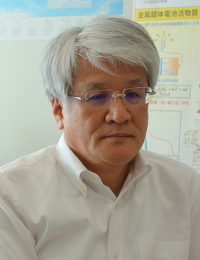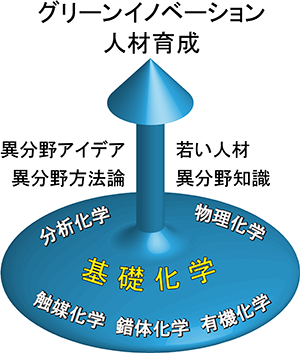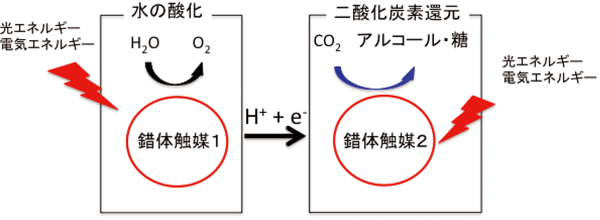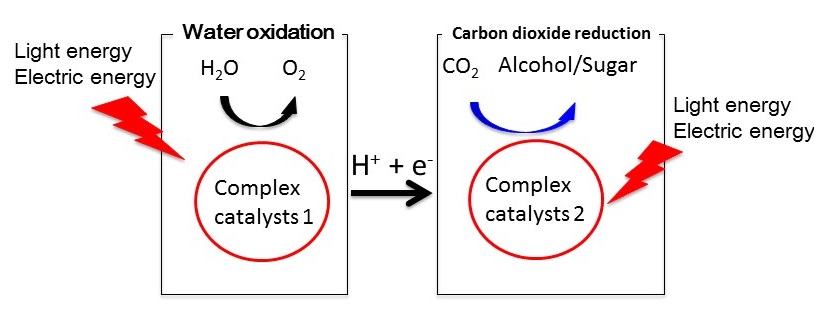キーワード: 人工光合成、水の酸化、二酸化炭素還元、グリーン化学
 自然界における光合成は、植物や藻類が光合成色素を介して光エネルギーを化学エネルギーに変換する機能で、大気・水中の二酸化炭素から炭水化物を合成しています。これを環境にやさしい金属錯体を触媒とした人工光合成に置き換え、生成される電子、プロトン(水素イオン)、アルコールをエネルギー資源として利用するグリーンイノベーションには大きな付加価値が生まれます。また、このような知識・経験をもった人材を社会に送り出すことにも大きな意義があります。本リサーチユニットでは、人材育成にも力を注いでいます。
自然界における光合成は、植物や藻類が光合成色素を介して光エネルギーを化学エネルギーに変換する機能で、大気・水中の二酸化炭素から炭水化物を合成しています。これを環境にやさしい金属錯体を触媒とした人工光合成に置き換え、生成される電子、プロトン(水素イオン)、アルコールをエネルギー資源として利用するグリーンイノベーションには大きな付加価値が生まれます。また、このような知識・経験をもった人材を社会に送り出すことにも大きな意義があります。本リサーチユニットでは、人材育成にも力を注いでいます。
若い研究者を育てるユニットのポリシー

図1:ユニットのコンセプト
近頃の大型研究プロジェクトは、ともするとすぐ役に立つ応用研究に重きを置いていますが、本ユニットでは20 − 30 年後のための基礎研究こそ必要であると考えています。
歴史を振り返るとイノベーションは全く異なる発想をもつ専門分野外研究者やフレキシブルで明晰な頭脳をもった若い人たち(若い専門家とは限りません)により達成されています。本ユニットのメンバーは錯体触媒および周辺分野の研究者から構成されています。このような研究集団からは、これまでの概念・常識に捕われない発想による物質開発が期待されます。また、リサーチリーダーは、この研究が学問的に魅力的であり、我々の研究が社会に貢献できることを学生にコンビンスさせ、また研究の自由度をもたせることが重要です。モチベーションとアイデアこそ本研究推進の駆動力になります。数年以内で私たちリサーチユニットが革新的なイノベーションを起こすことができるとは限りませんが、この研究に従事する若い人たちが、今後の日本の化学イノベーションにおいて重要な役割を担うことになると期待しています。(図1)
環境エネルギー問題に立ち向かう研究と人材育成の両立
光エネルギーを駆動力として、有機化合物の酸化的化学変換、水の酸化、CO2 の還元的固定化及び水素生成を可能(図2)とし、グリーンイノベーションとしての基礎化学及びその方法論を確立しようとしています。例えば、天然の光合成で見られる光合成システムを模倣して、光エネルギーを捕集、水を酸化、電子移動、二酸化炭素の還元を行なう光機能性複合超分子の構築を目指しています。さらに、学際的な本研究の遂行を通じて、化学における広い視野、深い知識と経験をもつ大学院生の教育、国際的競争に勝てる研究者の育成を目標においています。

図2:錯体触媒による水の酸化と二酸化炭素の還元
社会への貢献・実績
- 本リサーチユニットで創られる革新的物質による地球温暖化などの環境問題とエネルギー問題の解決
取材:平成26年6月30日
From artificial photosynthesis to green innovation
Unit name: Innovative Inorganic-Organic Research Unit
Key words: artificial photosynthesis, water oxidation, CO2 reduction, green chemistry
 In the world of nature, plants and algae photosynthesize carbon dioxide present in the atmosphere and water into carbohydrates, using the function to convert light energy into chemical energy through photosynthetic pigments. The research unit applies this mechanism to artificial photosynthesis using environmentally-friendly metal complexes as catalysts and aims to develop “green innovation” designed to generate electrons, protons (hydrogen ions), and alcohol. The unit also places an emphasis on human resource development, based on the idea that training researchers with knowledge and experience in these fields is of significance for the future society.
In the world of nature, plants and algae photosynthesize carbon dioxide present in the atmosphere and water into carbohydrates, using the function to convert light energy into chemical energy through photosynthetic pigments. The research unit applies this mechanism to artificial photosynthesis using environmentally-friendly metal complexes as catalysts and aims to develop “green innovation” designed to generate electrons, protons (hydrogen ions), and alcohol. The unit also places an emphasis on human resource development, based on the idea that training researchers with knowledge and experience in these fields is of significance for the future society.
The unit’s policy of training young researchers
Although most large-scale research projects, in recent years, place importance on practical applied research from a short-term perspective, we believe that basic researches are more important for future.
In the history, innovations were often accomplished by researchers as non-specialists with completely different ideas and flexible and clear-headed experts. The research unit consists of researchers specializing in metal complex catalysts and related fields. Such research groups are expected to develop of substances based on innovative ideas, rather than thinking inside the box or sticking to stereotypes. It is important for the research leader to both convince students that our research will contribute to society, and allow them to conduct research freely. Motivations and ideas will be the driving force for the promotion of the research. Although I cannot guarantee that our research unit will create innovation, I hope that young people involved in this research project will fulfill important roles in innovative chemical research in Japan (Figure 1).

Figure 1: The unit’s concept
Research to address environment and energy issues and human resource development
The research unit aims to establish basic chemistry for green innovation, in which oxidative chemical conversion of organic compounds, water oxidation, reductive CO2 immobilization, and hydrogen generation are accomplished using light energy as a driving force (Figure 2), as well as its methodologies. The unit simulates the natural photosynthesis system to develop supramolecules that conduct the collection of light energy, water oxidation, electron transfer, and carbon dioxide reduction. In addition, the unit conducts an interdisciplinary study to implement education for graduate students with a broad perspective in chemistry, in-depth knowledge, and a wealth of experience, and train competitive researchers at an international level.

Figure 2: Water oxidation and carbon dioxide reduction using complex catalysts
Social contributions and achievements
- Solution of environmental and energy issues including global warming using innovative substances developed by the research unit
Interviewed on June 30, 2014
